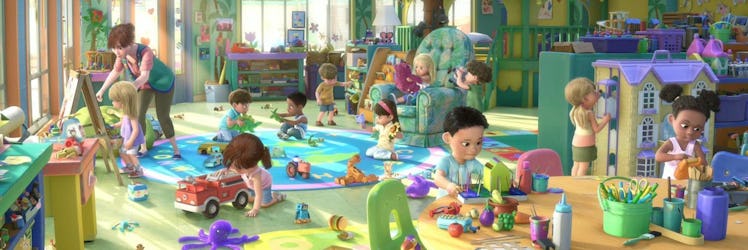The Definitive Glossary Of Preschool Programs, From Bank Street To Waldorf
Yes, your 3-year-old needs the appropriate curriculum.

If you thought preschool was as simple as dropping the kid off at the YMCA before work, guess again. Between names like Bank Street, HighScope, and Waldorf, it can feel more like you’re picking between wealth management firms than daycare that puts them on the path to kindergarten. But in a world where you have to camp out for a week just to get into one, knowing what those names mean can make a big difference down the line. Plus, you want the very best macaroni necklace money can buy. Only you can decide which preschool type is best for your kid, but with this glossary of the common options you’ll encounter, you’ll at least have an idea of what everyone’s getting into. Now get back to work on that application.
Bank Street
At Bank Street schools, children are active learners, explorers, and artists; they lead while teachers help steer them between snacks and naps. Opt for a Bank Street program if your kid needs a free-form schedule or you want them to learn about several things at once in a group setting. Bank Street kids, who sound like they should be wearing tiny wingtips and pantsuits, engage with experiential, hands-on, imaginative activities like blocks, puzzles, clay, and dress-up, which seems remarkably relevant for an approach rooted in John Dewey’s educational philosophy. He of the Dewey Decimal System. And so the card catalog lives on in the screen time generation. Life finds a way …Bankstreet.edu
Cooperative
When parents either can’t choose between any of the programs on this list or straight up think they can do better, they start their own co-op preschool. If you choose this route, you’ll be directly involved with your kid’s (and a bunch of other people’s kids’) daily experiences and classroom teachers, and take turns on the school’s board of directors. In other words, you’re telling the world you hate what little free time you still have. Cooperative preschools do have the noble goal of teaching preschoolers cooperation and conflict resolution, which of course is best achieved by putting a bunch of different parents in the same place at the same time. CoOpSchools.com
HighScope
If you side with child development wonks who say kids need experiences in math, reading, and science before they can count, read, or … science, go HighScope. Everything about their “active participatory learning” approach is meticulously organized, from classrooms to daily routines prescribing 58 key experiences in 10 core categories: time, space, numbers, seriation, creative representation, language, social relations, music, movement, and classification. Unlike Waldorf programs, computers are regularly involved. So are adults, as the curriculum emphasizes “shared control” — kids and grownups learning together. So send your kid here if you want to start doing their homework as early as possible (Or even earlier — some HighScope schools have young toddler and even infant programs. The only prerequisite is potty training.). Highscope.org
Montessori
The one name on this list you’ve heard of, thanks to their 5,000 schools in North America. A development-focused curriculum stresses practical life skills, sensory awareness, language, math, and culture, as teachers guide kids (they’re literally called “Guides”) to find meaning and purpose within the interconnected natural world. To that end, Montessori schools seek a diverse student body. Montessori best suits those requiring hands-on learning and attention focused on their needs — that’s for kids and parents, who are closely involved. Teachers are instructed to follow the lead of each kid and limit how much guidance they give, which seems like a waste of the undergraduate and graduate degrees and Montessori certification they’re instructed to get. Montessori.org
Reggio Emilia
This style, founded in 1940s Italy, isn’t a set curriculum or credentialed method but a philosophy and practice. Like how Nonna doesn’t need a recipe to make the best Sunday Sauce EVER. As with Montessori and others on this list, Reggio Emilia schools encourage exploration, self-expression, and community through open-ended, child-led art projects and activities reflecting their interests. The buzz-word here is “project-based.” Essentially, a kid asks about a bug they find and the teacher encourages all the kids to learn about it together instead of answering any questions — except, “Can I eat it?” Teacher should really answer that. Reggio Emilia programs are also known for documenting everything, so send your kid to one if you want loads of photos, wish to raise a cooperative, good citizen, or hope that your kid’s interest in macaroni art turns into a project-based exploration of how to make rigatoni bolognese (mmm … gravy). ReggioChildren.it
Waldorf
A 19th century Austrian writer named Rudolf Steiner launched this program aimed at nurturing what he believed to be the 3 core aspects of every individual: spirit, soul, and body. This is achieved through supportive, hands-on, group learning and free play that engages all 5 senses. So you won’t find Montessori-like individual attention or TVs and app-connected toys, but you will find painting, coloring, singing, baking, building box forts, and dressing up like magicians. Waldorf kids thrive on rhythmic repetition and order. Basically, ol’ Rudy was some kind of before-his-time hippie who figured kids learn best in drum circles. And with that, you may now add “Preschool” beside “Salad” and “Astoria” on your “List Of Words That Come After ‘Waldorf.'” WaldorfEducation.org
This article was originally published on